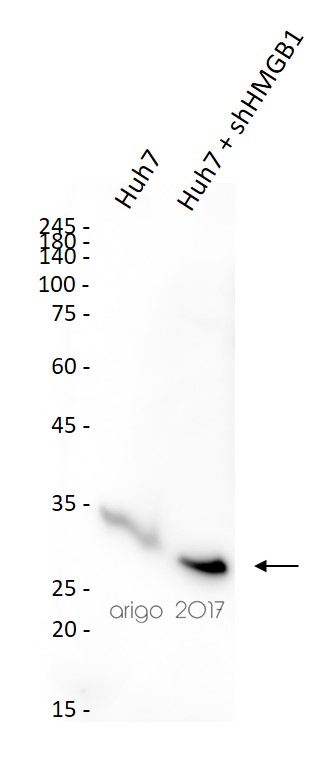ARG57506
anti-HMGB2 antibody
anti-HMGB2 antibody for Western blot and Human,Mouse,Rat

1
Overview
| Product Description | Rabbit Polyclonal antibody recognizes HMGB2 |
|---|---|
| Tested Reactivity | Hu, Ms, Rat |
| Tested Application | WB |
| Host | Rabbit |
| Clonality | Polyclonal |
| Isotype | IgG |
| Target Name | HMGB2 |
| Antigen Species | Human |
| Immunogen | Synthetic peptide of Human HMGB2. |
| Conjugation | Un-conjugated |
| Alternate Names | HMGB2; High Mobility Group Box 2; HMG2; High-Mobility Group (Nonhistone Chromosomal) Protein 2; High Mobility Group Protein B2; High Mobility Group Protein 2; HMG-2; High-Mobility Group Box 2 |
Application Instructions
| Application Suggestion |
|
||||
|---|---|---|---|---|---|
| Application Note | * The dilutions indicate recommended starting dilutions and the optimal dilutions or concentrations should be determined by the scientist. |
Properties
| Form | Liquid |
|---|---|
| Purification | Affinity purification with immunogen. |
| Buffer | PBS (pH 7.3), 0.02% Sodium azide and 50% Glycerol. |
| Preservative | 0.02% Sodium azide |
| Stabilizer | 50% Glycerol |
| Storage Instruction | For continuous use, store undiluted antibody at 2-8°C for up to a week. For long-term storage, aliquot and store at -20°C. Storage in frost free freezers is not recommended. Avoid repeated freeze/thaw cycles. Suggest spin the vial prior to opening. The antibody solution should be gently mixed before use. |
| Note | For laboratory research only, not for drug, diagnostic or other use. |
Bioinformation
| Database Links | |
|---|---|
| Gene Symbol | HMGB2 |
| Gene Full Name | high mobility group box 2 |
| Background | This gene encodes a member of the non-histone chromosomal high mobility group protein family. The proteins of this family are chromatin-associated and ubiquitously distributed in the nucleus of higher eukaryotic cells. In vitro studies have demonstrated that this protein is able to efficiently bend DNA and form DNA circles. These studies suggest a role in facilitating cooperative interactions between cis-acting proteins by promoting DNA flexibility. This protein was also reported to be involved in the final ligation step in DNA end-joining processes of DNA double-strand breaks repair and V(D)J recombination. [provided by RefSeq, Jul 2008] |
| Function | DNA binding proteins that associates with chromatin and has the ability to bend DNA. Binds preferentially single-stranded DNA. Involved in V(D)J recombination by acting as a cofactor of the RAG complex. Acts by stimulating cleavage and RAG protein binding at the 23 bp spacer of conserved recombination signal sequences (RSS) (By similarity). [UniProt] |
| Calculated MW | 24 kDa |
| PTM | Reduction/oxidation of cysteine residues Cys-23, Cys-45 and Cys-106 and a possible intramolecular disulfide bond involving Cys-23 and Cys-45 give rise to different redox forms with specific functional activities in various cellular compartments: 1- fully reduced HMGB2 (HMGB2C23hC45hC106h), 2- disulfide HMGB2 (HMGB2C23-C45C106h) and 3- sulfonyl HMGB2 (HMGB2C23soC45soC106so). Acetylation enhances nucleosome binding and chromation remodeling activity. |
Images (1) Click the Picture to Zoom In








